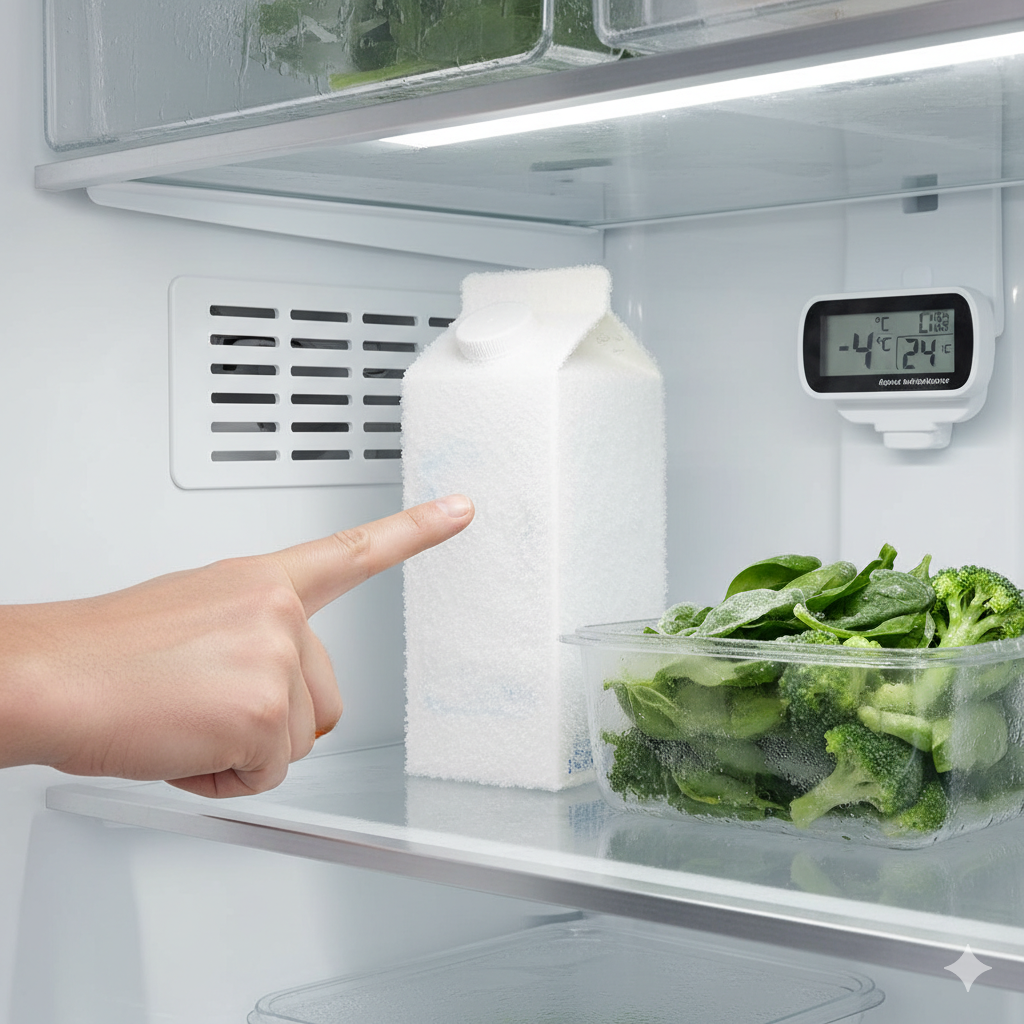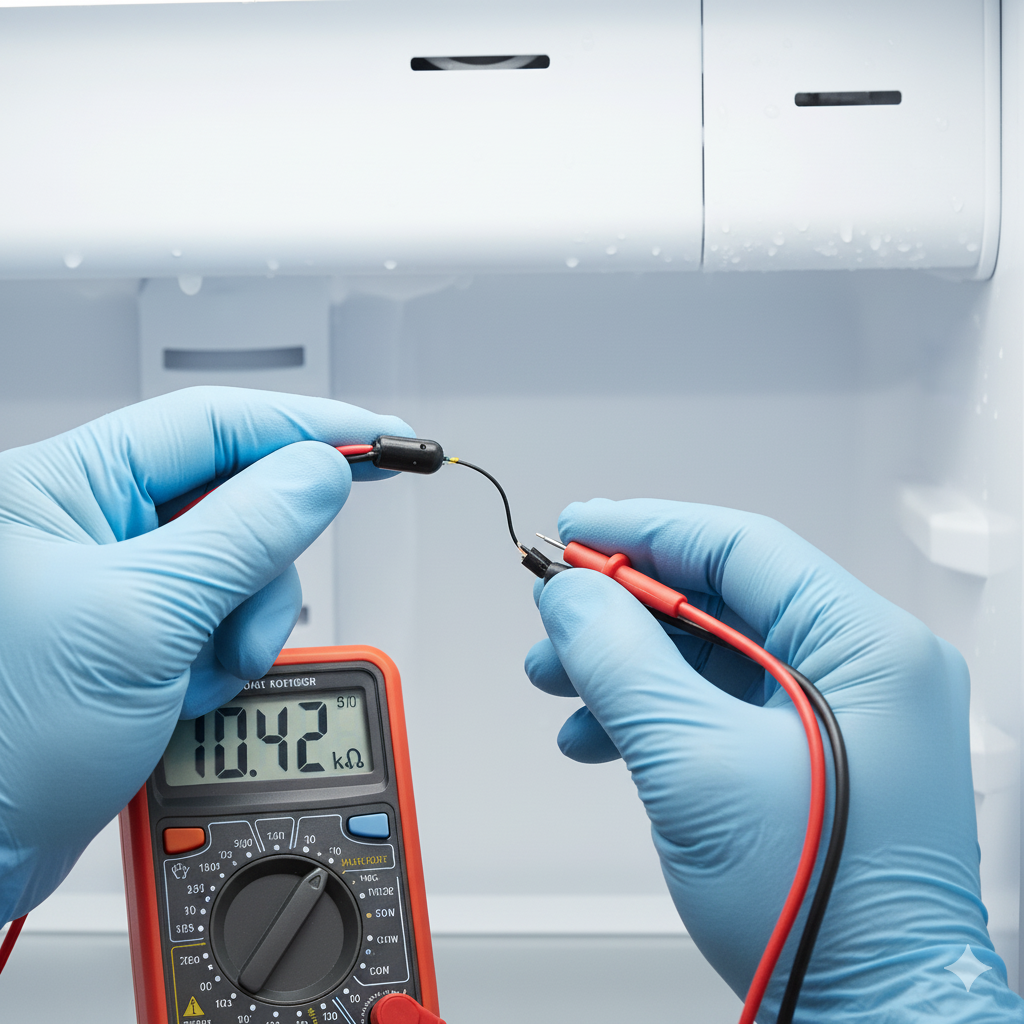Diagnosing and Repairing Cold Air Regulation Failure
Few appliance problems are as frustrating as opening your refrigerator, only to find the lettuce is frozen solid, the milk has ice crystals, and the yogurt is splitting. When the fresh food section is freezing items, it means your refrigerator is failing to regulate the supply of cold air from the freezer.
This problem is usually caused by one of two components that control cold airflow: the air damper control or the main control board (thermistor). This guide will walk you through the steps to quickly diagnose and fix the issue.
Step 1: Check the Basics (Before Repair)
Before assuming a technical failure, rule out simple user errors that can lead to freezing.

Always check your refrigerator’s thermostat setting and avoid placing sensitive foods directly in front of cold air vents, which can cause freezing.
1. Check Thermostat Settings
- Rule of Thumb: Ensure your refrigerator is set between $37^circ F$ and $40^circ F$ ($3^circ C$ and $4^circ C$). If it was accidentally set to the coldest setting, even a small temperature spike could trigger freezing.
- Use a Thermometer: Use an external refrigerator thermometer (not the display) to confirm the actual temperature inside the compartment.
2. Check Food Placement
- Air Vents: Never place temperature-sensitive items (like milk, eggs, or lettuce) directly in front of or below the cold air vent (the duct where air enters from the freezer). This air is near $0^circ F$ and will immediately freeze food placed next to it.
- Rear Wall: Do not push items up against the refrigerator’s rear wall, as this area is the coldest part of the compartment.
Step 2: Inspect and Test the Air Damper Control
The air damper control is a small, motorized or mechanical gate that opens and closes the vent between the freezer and the fresh food compartment. Its job is to precisely meter the amount of cold air required.
If the damper is stuck in the fully open position, too much cold air floods the fridge, causing freezing.

The air damper control regulates cold air from the freezer. If it’s stuck open due to ice or debris, too much cold air enters the fridge, freezing food.
Location and Access
The damper is usually located high up on the back wall of the fresh food section, sometimes hidden behind a light assembly or a plastic housing.
- Locate the Damper: Find the plastic housing where the cold air vent is located.
- Inspect for Jamming: Unplug the refrigerator and remove the plastic cover. Inspect the mechanical flap (the damper) for ice or debris that may be holding it open. If it’s jammed with ice, use a hairdryer on a low setting to melt the ice, then manually move the flap to ensure it operates freely.
- Test the Motor (Electronic Dampers): In electronic models, the damper is driven by a small motor. If the damper is physically clear but remains open even when set to a warmer temperature, the motor itself may be faulty. This requires testing the motor for continuity or simply replacing the entire damper assembly.
Step 3: Check the Temperature Sensor (Thermistor)
The thermistor is a small temperature-sensing probe located within the fridge compartment, often near the light assembly or control panel. It tells the control board the current temperature so the board knows whether to open or close the air damper.

The thermistor reports temperature to the control board. If it’s faulty, it can send incorrect signals, causing the refrigerator to over-cool and freeze food.
If the thermistor fails, it may send an artificially “warm” signal to the control board, tricking the board into opening the damper and running the fan constantly, which results in freezing.
The Fix (Requires a Multimeter)
- Locate the Thermistor: Refer to your appliance’s wiring diagram or technical manual for the exact location (usually clipped onto the interior wall or secured near the fan).
- Test Resistance: Unplug the fridge and disconnect the thermistor wires. Use a multimeter set to measure resistance ($Omega$). The expected resistance reading is highly dependent on the unit’s temperature.
- Consult Chart: You must look up your specific model’s diagnostic chart, but generally, resistance drops as temperature rises. If the reading is infinity or zero, the thermistor is faulty.
- Replace: If the thermistor is faulty, replace it. It’s an inexpensive component and a relatively simple replacement, as it usually just clips into place.
When to Call a Professional Appliance Technician
If you have inspected and replaced the damper control and confirmed the thermistor is working, the freezing problem may stem from a more complex failure:
- Main Control Board: If all components are working but the system still sends constant cold air, the fault lies with the main electronic control board, which manages all temperature logic. This is an expensive repair best handled by a professional.
- Sealed System: In rare cases, a refrigerant leak can cause erratic cooling cycles, leading to over-cooling in one section. This requires licensed refrigerant handling.
Need professional appliance repair for complex temperature issues in the Marietta area?
Our certified technicians can quickly diagnose and resolve problems stemming from faulty control boards, dampers, and sensors, restoring safe temperatures to your appliance.
| Powers Park | Fair Oaks | Noonday | Blackwells |
| Sandy Plains | Chattahoochee Plantation | Marietta | Vinings |
| Westoak | Powder Springs | Cumberland | Acworth |
| Kennesaw | Macland | Lost Mountain | Smyrna |
| East Cobb | Mars Hill | Clarkdale Park |
